
Napalm
The oldest type of chemical weapon

Simon Cotton
University of Birmingham

Molecule of the Month December 2022

|
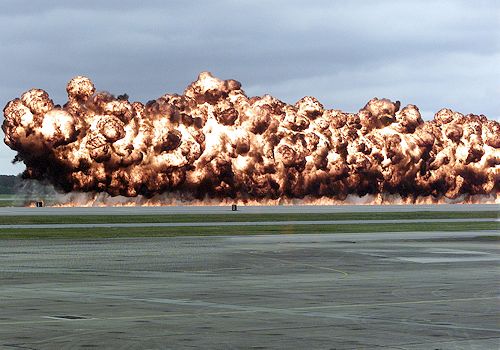
A simulation of a napalm explosion at an air show in 2003 by the US Marine Corps.
[Official USMC photo by LCpl Andrew Pendracki, Public domain, via Wikimedia Commons] |
How long has it been used?
In its present form, since World War II. But in its genesis, you have to look back around 2000 years.
How so?
The distinguished scholar Adrienne Mayor (Stanford) has looked into unusual weapons of the classical era. She pointed out that the Persians under the emperor Xerxes the Great used flaming arrows. Then the Romans put a mixture of burning pitch and sulfur on their spears. Just watch the Russell Crowe film, Gladiator.
How did they manage that?
They had discovered crude oil. You may remember that it has subsequently enriched several countries in the Near East. An inflammable water-like substance called nepthar is mentioned in the King James Bible (2 Maccabees 1:36), dating from around 200 BC.
And....?
The centre of the Roman Empire moved to Byzantium (the site of the present-day Istanbul). They developed a mixture known as Greek fire, thought to use components including naphtha, pine resin (containing substances like pinene and sulfur (amongst others), and which formed a mixture that burned at high temperatures and could be projected long distances under pressure: the original flamethrower.
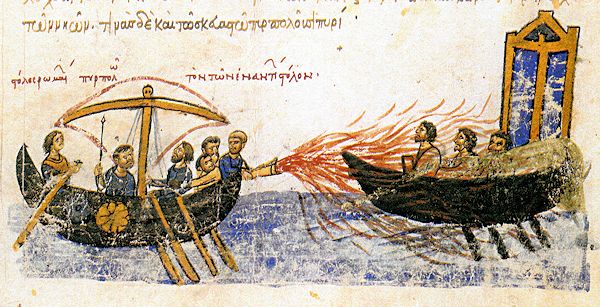
A Byzantine ship using Greek fire against a ship belonging to the rebel Thomas the Slav, 821. 12th century illustration.
[Image: Public domain, via Wikimedia Commons]
Naphtha has bigger alkane molecules than you find in petrol (typically C7-C12), so although it is harder to ignite than the ones found in petrol, it burns for longer.
Greek fire did not just burn at very high temperatures, it stuck to things it contacted, including unlucky enemy troops. The toxic SO2 (MOTM Dec 2003) formed as it burned would have added to its lethality. Byzantium used it to fight off besieging naval forces.
So it continued in use?
No, the secret of Greek fire seems to have been lost, possibly after the fall of Byzantium in AD 1453.
Why doesn’t anyone know?
The secret was probably kept within a small (family?) circle and transmitted by word of mouth. But recent reconstructions using light crude oil and pine resin have proved very effective.
So where did napalm itself come from?
Louis Fieser.
Who is he?
Louis Frederick Fieser (1899-1977) did research for his PhD at Harvard (1924); he later became a professor at Harvard from 1930 until his appointment as an emeritus professor on retirement in 1968. Together with his wife Mary (1909-1997) he wrote several organic chemistry texts that saw widespread use, notably Advanced Organic Chemistry and Reagents for Organic Synthesis. He was both a successful researcher (e.g. synthesis of Vitamin K, MOTM May 2016) and a popular teacher of undergraduate students, in lecture room and laboratory alike. During World War II, Fieser was engaged in research to support the American war effort.
|
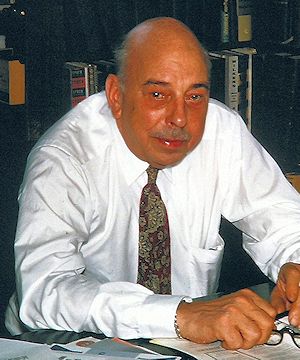
Louis Fieser in 1965.
[Photo: Peter Geymayer, Public domain, via Wikimedia Commons] |
Weapons like flame-throwers had been used before, notably during World War I. These were gasoline-based, and not too successful, because the petrol burned too fast. Fieser found that if he added a thickening agent to the fuel meant that the mixture was longer-burning, and also tended to stick to surfaces. One formulation for the thickening agent used a mixture of aluminum naphthenate and aluminium palmitate.
 |
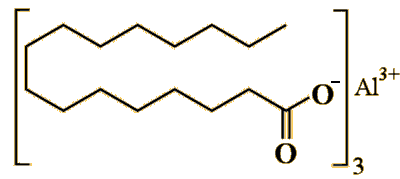 |
| Aluminium naphthenate |
Aluminium palmitate |
Which meant?
Fieser spotted that if you combined the first parts of the words naphthalene and palmitate you got the word napalm. Combining this thickening agent with gasoline led to a weapon that burned slowly and gave higher temperatures.
It was used in both the European and Pacific theatres of war. It proved to be a very effective weapon, whether on the Normandy invasion beaches or the city of Tokyo. Indeed, the German word "bombenbrandschrumpfleichen" was created in response to napalm bombing of German bunkers. It means "firebomb shrunken flesh" because soldiers in bunkers would be baked by the heat.

A U.S. riverboat deploying napalm in the form of a flamethrower during the Vietnam War.
[Photo: U.S. Navy, Public domain, via Wikimedia Commons]
And after World War II?
Napalm was used on a broader front. The Greek government employed it against Communist guerrillas in 1948-9, whilst the Korean War saw its use on a wide scale. Israel and Egypt used it in their periodic wars. And further developments in the formulation of napalm took place.
Making it even nastier?
Certainly. Very reactive metals like sodium and potassium could be added to the mixture, or pyrophoric white phosphorus (P4), not to mention the very nasty triethylaluminium ({(C2H5)3Al}2), also pyrophoric.
 |
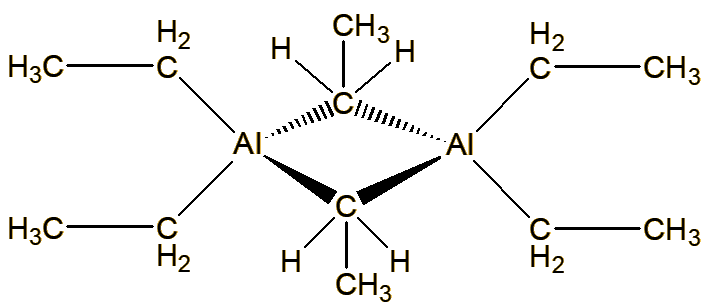 |
| White phosphorus (P4) |
Triethylaluminium |
Then it was found that if you mixed polystyrene (see MOTM for styrene, September 2021) with benzene and gasoline, the product was less flammable and easier to handle. Although it contained neither naphthalene nor palmitate, it became known as napalm B, super-napalm, or NP2. One of Napalm-B's safety features was that it was rather difficult to ignite, decreasing the chances of an accidental ignition. Thermite, a chemical mixture of Al and iron oxide powders that burns at very high temperatures, is often used with a fuse to ignite Napalm-B. Burning napalm B would set peoples’ clothing on fire and produce 4th or 5th degree burns penetrating right through the skin.
And of course, it was used in Vietnam.
Indeed, in the Vietnam War it was often used alongsde the defoliant Agent Orange (MOTM Dec 2000) to try to deprive the Viet Cong of their jungle hiding places. One of the most famous movie quotes came from the lips of Robert Duvall’s character (Col. Bill Kilgore) in the film Apocalypse Now: ‘I love the smell of napalm in the morning’. Napalm was used extensively by the U.S. and South Vietnamese forces.

Robert Duvall in Apocalypse Now.
Phan Thị Kim Phúc is probably the most famous victim of napalm. As a nine-year old girl, she was part of a column of civilians that was mistakenly the victim of a South Vietnamese napalm attack on June 8th 1972. She survived by tearing off her burning clothes; an iconic photograph of her running down the road has come to symbolise the futility of that war. Kim Phúc, as she is usually known, somehow survived her extensive burns, and went on to study medicine at the University of Havana. Subsequently she claimed asylum in Canada, married and had two children.
What about public opinion?
The photo of Phan Thị Kim Phúc and others like it helped to galvanize the anti-Vietnam-war movement in the United States. There were extensive protests against the Dow Chemical Company, which manufactured napalm for the U.S. government from 1965 to 1969, along with boycotts of its products across the country. On university campuses, recruiters for Dow faced angry protests, sometimes ending up with the recruiters barricaded in buildings. Dow replied, saying that it had a responsibility to the U.S. government to fulfill its requests for napalm, but after Dow's contract expired, napalm production switched to another company, American Electric Inc.
Was the Vietnam war the last time napalm was used?
By no means! Many countries have used napalm in multiple wars since then, most notable Israel in the wars in 1967 and 1973, the Argentinians in the Falklands war (1982), the Serbs in the Bosnian war (1994), and the Turks used it against Kurdish vilages in 1997. In Syria, Human Rights Watch documented over 120 incidents involving incendiary weapons from 2012 to 2018 by the Syrian-Russian military alliance. And there are even reports of the Russians using a modified napalm rocket in the current war in Ukraine.
Why hasn't it been banned?
The United Nations did ban the use of napalm in 1980 as party of the Geneva Convention (Protocol 3) but only against civilian targets (or against military targets in civilian areas). Most countries complied with this, and the use of traditional napalm has now almost stopped. But many countries, including the USA, use modern incendiary variants instead which they claim are different to old napalm and so are not covered by the treaty. The MK-77 bomb is an incendiary bomb used by the US which uses kerosene-based fuel with a lower concentration of benzene, and so technically contains none of the original components of napalm, although it still functions in exactly the same way. It is reported to also contain an oxidizing agent as well as white phosphorus, making it more difficult to put out once ignited.
The MK-77 bomb was used in Iraq (Operations Desert Storm 1991 and Iraqi Freedom (2003-2011)) and at the Battle of Tora Bora in 2001 during the Afghan War, as well as during the 2003 Invasion of Iraq.
|
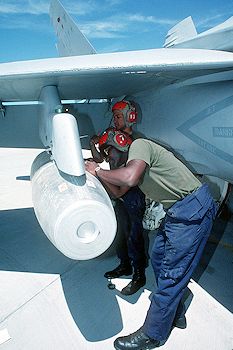
A Mark 77 bomb being loaded on an F/A-18 Hornet in 1993.
[Photo: PH2 Bruce Trombecky, Public domain, via Wikimedia Commons] |
So, whatever name it goes by, it seems napalm-like weapons will still be used in wars for some time to come...

Bibliography
- Robert M. Neer, Napalm: An American Biography, Cambridge, Mass, The Belknap Press, 2013.
- Dieter Lenoir and Thomas T. Tidwell, Louis Fieser: An Organic Chemist in Peace and War, Eur. J. Org. Chem., 2009, 481–484.
- Adrienne Mayor, Greek Fire, Poison Arrows, and Scorpion Bombs: Unconventional Warfare in the Ancient World, 1st edition, 2003, London, Duckworth, pp 207 ff.; 2nd edition 2022, pp 221 ff.
- Napalm use in War
- UN Protocol 3
- What Is Napalm And Is It Still Used In Warfare?


 Back to Molecule of the Month page. [DOI:10.6084/m9.figshare.20465913]
Back to Molecule of the Month page. [DOI:10.6084/m9.figshare.20465913]
![]()
![]()
![]()
![]()









